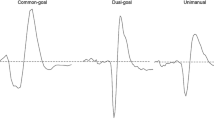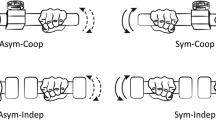Abstract
When two hands require different information in bimanual asymmetric movements, interference can occur via callosal connections and ipsilateral corticospinal pathways. This interference could potentially work as a cost-effective measure in symmetric movements, allowing the same information to be commonly available to both hands at once. Using functional magnetic resonance imaging, we investigated supra-additive and sub-additive neural interactions in bimanual movements during the initiation and continuation phases of movement. We compared activity during bimanual asymmetric and symmetric movements with the sum of activity during unimanual right and left finger-tapping. Supra-additive continuation-related activation was found in the right dorsal premotor cortex and left cerebellum (lobule V) during asymmetric movements. In addition, for unimanual movements, the right dorsal premotor cortex and left cerebellum (lobule V) showed significant activation only for left-hand (non-dominant) movements, but not for right-hand movements. These results suggest that resource-demanding interactions in bimanual asymmetric movements are involved in a non-dominant hand motor network that functions to keep non-dominant hand movements stable. We found sub-additive continuation-related activation in the supplementary motor area (SMA), bilateral cerebellum (lobule VI) in symmetric movements, and the SMA in asymmetric movements. This suggests that no extra demands were placed on these areas in bimanual movements despite the conventional notion that they play crucial roles in bimanual coordination. Sub-additive initiation-related activation in the left anterior putamen suggests that symmetric movements place lower demands on motor programming. These findings indicate that, depending on coordination patterns, the neural substrates of bimanual movements either exhibit greater effort to keep non-dominant hand movements stable, or save neural cost by sharing information commonly to both hands.



Similar content being viewed by others
References
Aizawa H, Mushiake H, Inase M, Tanji J (1990) An output zone of the monkey primary motor cortex specialized for bilateral hand movement. Exp Brain Res 82:219–221
Aramaki Y, Honda M, Okada T, Sadato N (2006) Neural correlates of the spontaneous phase transition during bimanual coordination. Cereb Cortex 16:1338–1348
Bengtsson SL, Ehrsson HH, Forssberg H, Ullen F (2005) Effector-independent voluntary timing: behavioural and neuroimaging evidence. Eur J Neurosci 22:3255–3265
Brinkman C (1984) Supplementary motor area of the monkeys cerebral-cortex—short-term and long-term deficits after unilateral ablation and the effects of subsequent callosal section. J Neurosci 4:918–929
Cardoso de Oliveira S (2002) The neuronal basis of bimanual coordination: recent neurophysiological evidence and functional models. Acta Psychol (Amst) 110:139–159
Chan JL, Ross ED (1988) Left-handed mirror writing following right anterior cerebral artery infarction: evidence for nonmirror transformation of motor programs by right supplementary motor area. Neurology 38:59–63
Diedrichsen J, Grafton S, Albert N, Hazeltine E, Ivry RB (2006) Goal-selection and movement-related conflict during bimanual reaching movements. Cereb Cortex 16:1729–1738
Diedrichsen J, Criscimagna-Hemminger SE, Shadmehr R (2007) Dissociating timing and coordination as functions of the cerebellum. J Neurosci 27:6291–6301
Friston KJ, Ashburner J, Poline JB, Frith CD, Heather JD, Frackowiak RSJ (1995a) Spatial registration and normalization of images. Hum Brain Mapp 2:165–189
Friston KJ, Holmes AP, Worsley KJ, Poline JP, Frith CD, Frackowiak RSJ (1995b) Statistical parametric maps in functional imaging: a general linear approach. Hum Brain Mapp 2:189–210
Friston KJ, Holmes A, Poline JB, Price CJ, Frith CD (1996) Detecting activations in PET and fMRI: levels of inference and power. Neuroimage 4:223–235
Friston KJ, Holmes AP, Worsley KJ (1999) How many subjects constitute a study? Neuroimage 10:1–5
Grahn JA, Brett M (2007) Rhythm and beat perception in motor areas of the brain. J Cogn Neurosci 19:893–906
Grodd W, Hulsmann E, Lotze M, Wildgruber D, Erb M (2001) Sensorimotor mapping of the human cerebellum: fMRI evidence of somatotopic organization. Hum Brain Mapp 13:55–73
Halsband U, Ito N, Tanji J, Freund HJ (1993) The role of premotor cortex and the supplementary motor area in the temporal control of movement in man. Brain 116(Pt 1):243–266
Heuer H, Kleinsorge T, Spijkers W, Steglich W (2001) Static and phasic cross-talk effects in discrete bimanual reversal movements. J Mot Behav 33:67–85
Immisch I, Waldvogel D, van Gelderen P, Hallett M (2001) The role of the medial wall and its anatomical variations for bimanual antiphase and in-phase movements. Neuroimage 14:674–684
Ivry RB, Spencer RM (2004) The neural representation of time. Curr Opin Neurobiol 14:225–232
Ivry RB, Keele SW, Diener HC (1988) Dissociation of the lateral and medial cerebellum in movement timing and movement execution. Exp Brain Res 73:167–180
Kelso JA (1984) Phase transitions and critical behavior in human bimanual coordination. Am J Physiol 246:R1000–R1004
Kimura M (1990) Behaviorally contingent property of movement-related activity of the primate putamen. J Neurophysiol 63:1277–1296
Kraft E, Chen AW, Flaherty AW, Blood AJ, Kwong KK, Jenkins BG (2007) The role of the basal ganglia in bimanual coordination. Brain Res 1151:62–73
Lehericy S, Ducros M, Krainik A, Francois C, Van de Moortele PF, Ugurbil K, Kim DS (2004a) 3-D diffusion tensor axonal tracking shows distinct SMA and pre-SMA projections to the human striatum. Cereb Cortex 14:1302–1309
Lehericy S, Ducros M, Van de Moortele PF, Francois C, Thivard L, Poupon C, Swindale N, Ugurbil K, Kim DS (2004b) Diffusion tensor fiber tracking shows distinct corticostriatal circuits in humans. Ann Neurol 55:522–529
Lewis PA, Wing AM, Pope PA, Praamstra P, Miall RC (2004) Brain activity correlates differentially with increasing temporal complexity of rhythms during initialisation, synchronisation, and continuation phases of paced finger tapping. Neuropsychologia 42:1301–1312
Mechsner F, Kerzel D, Knoblich G, Prinz W (2001) Perceptual basis of bimanual coordination. Nature 414:69–73
Meyer-Lindenberg A, Ziemann U, Hajak G, Cohen L, Berman KF (2002) Transitions between dynamical states of differing stability in the human brain. Proc Natl Acad Sci USA 99:10948–10953
Müller K, Kleiser R, Mechsner F, Seitz RJ (2009) Perceptual influence on bimanual coordination: an fMRI study. Eur J Neurosci 30:116–124
Oldfield RC (1971) The assessment and analysis of handedness: the Edinburgh inventory. Neuropsychologia 9:97–113
Rao SM, Mayer AR, Harrington DL (2001) The evolution of brain activation during temporal processing. Nat Neurosci 4:317–323
Romo R, Scarnati E, Schultz W (1992) Role of primate basal ganglia and frontal cortex in the internal generation of movements. II. Movement-related activity in the anterior striatum. Exp Brain Res 91:385–395
Sadato N, Yonekura Y, Waki A, Yamada H, Ishii Y (1997) Role of the supplementary motor area and the right premotor cortex in the coordination of bimanual finger movements. J Neurosci 17:9667–9674
Sakai ST, Inase M, Tanji J (1999) Pallidal and cerebellar inputs to thalamocortical neurons projecting to the supplementary motor area in Macaca fuscata: a triple-labeling light microscopic study. Anat Embryol (Berl) 199:9–19
Sakai ST, Inase M, Tanji J (2002) The relationship between MI and SMA afferents and cerebellar and pallidal efferents in the macaque monkey. Somatosens Mot Res 19:139–148
Schaal S, Sternad D, Osu R, Kawato M (2004) Rhythmic arm movement is not discrete. Nat Neurosci 7:1136–1143
Schell GR, Strick PL (1984) The origin of thalamic inputs to the arcuate premotor and supplementary motor areas. J Neurosci 4:539–560
Schmahmann JD, Doyon J, Toga A, Petrides M, Evans A (2000) MRI atlas of the human cerebellum. Academic Press, San Diego
Semjen A, Summers JJ, Cattaert D (1995) Hand coordination in bimanual circle drawing. J Exp Psychol Human Percept Perform 21:1139–1157
Stephan KM, Binkofski F, Halsband U, Dohle C, Wunderlich G, Schnitzler A, Tass P, Posse S, Herzog H, Sturm V, Zilles K, Seitz RJ, Freund HJ (1999) The role of ventral medial wall motor areas in bimanual co-ordination. A combined lesion and activation study. Brain 122(Pt 2):351–368
Swinnen SP, Wenderoth N (2004) Two hands, one brain: cognitive neuroscience of bimanual skill. Trends Cogn Sci 8:18–25
Timmann D, Watts S, Hore J (1999) Failure of cerebellar patients to time finger opening precisely causes ball high-low inaccuracy in overarm throws. 82:103–114
Timmann D, Citron R, Watts S, Hore J (2001) Increased variability in finger position occurs throughout overarm throws made by cerebellar and unskilled subjects. J Neurophysiol 86:2690–2702
Wiesendanger R, Wiesendanger M (1985) The thalamic connections with medial area 6 (supplementary motor cortex) in the monkey (Macaca fascicularis). Exp Brain Res 59:91–104
Acknowledgments
This study was supported in part by a Grant-in-Aid for Young Scientists (B) # 20700479 (YA) and (S) #17100003 (NS) from the Japan Society for the Promotion of Science, and Special Coordination Funds for Promoting Science and Technology from the Ministry of Education, Culture, Sports, Science and Technology, the Japanese Government. We are very grateful to Mr. Toshinori Yoshioka (CNS Technical Support Group in ATR) for his technical support.
Author information
Authors and Affiliations
Corresponding author
Electronic supplementary material
Below is the link to the electronic supplementary material.
Rights and permissions
About this article
Cite this article
Aramaki, Y., Osu, R. & Sadato, N. Resource-demanding versus cost-effective bimanual interaction in the brain. Exp Brain Res 203, 407–418 (2010). https://doi.org/10.1007/s00221-010-2244-0
Received:
Accepted:
Published:
Issue Date:
DOI: https://doi.org/10.1007/s00221-010-2244-0




